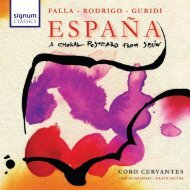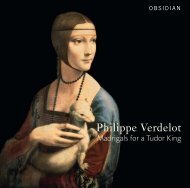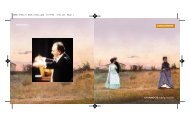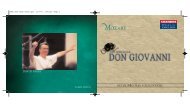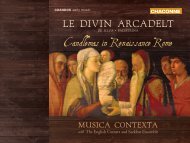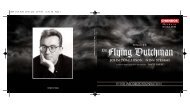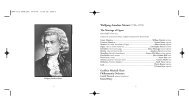ALSO AVAILABLE on SIGNUMclassics - Chandos
ALSO AVAILABLE on SIGNUMclassics - Chandos
ALSO AVAILABLE on SIGNUMclassics - Chandos
Create successful ePaper yourself
Turn your PDF publications into a flip-book with our unique Google optimized e-Paper software.
Bach Transcribed<br />
Violin S<strong>on</strong>ata No.1 in G minor<br />
L. Godowsky<br />
1. Adagio [5.07]<br />
2. Fuga [4.09]<br />
3. Siciliana [3.51]<br />
4. Presto [Finale] [3.18]<br />
5. Sheep May Safely Graze E. Petri [5.18]<br />
6. Air from the Orchestral Suite No.3 in D major A. Siloti [5.33]<br />
7. Gavotte (Tempo di Borea) from the C. Saint-Säens [3.19]<br />
Violin Partita No.1 in B minor<br />
8. Andante from the Violin S<strong>on</strong>ata No.2 in A minor A. Siloti [4.52]<br />
9. Siciliano from the Flute S<strong>on</strong>ata in Eb major A. Siloti [2.18]<br />
10. “Zi<strong>on</strong> hört die Wächter singen”, from the Cantata W. Kempff [5.17]<br />
BWV 140 “Wachet auf, ruft uns die Stimme”<br />
11. Largo from the Keyboard C<strong>on</strong>certo in F minor A. Bax [3.43]<br />
12. Bourreé from Cello Suite No.3 in C major L. Godowsky [4.30]<br />
13. Chac<strong>on</strong>ne from the Violin Partita No.2 in D minor F. Bus<strong>on</strong>i [14.28]<br />
Total Timings [65.45]<br />
Alessio Bax piano<br />
www.signumrecords.com<br />
Today it is remarkable to realise that there was a<br />
time when Bach was viewed as a respectable and<br />
learned rather than inspired composer, serious to<br />
a fault and designed for an essentially cold and<br />
academic taste. His children referred to him as<br />
‘the old wig’ and it wasn’t until the nineteenth<br />
century that awareness of his true stature (aided<br />
by Mendelssohn’s enthusiasm) occurred. Only then<br />
did musicians become c<strong>on</strong>scious of the unique<br />
depth and spiritual dimensi<strong>on</strong> of his allencompassing<br />
art, a small step towards seeing<br />
him as the true father of music. For many the 48<br />
Preludes and Fugues remain the ‘Old Testament’<br />
of music (with Beethoven’s 32 Piano S<strong>on</strong>atas<br />
following as the New). Yet there is nothing of the<br />
old in so many of Bach’s boldly experimental<br />
works, in The Art of Fugue, the Goldberg<br />
Variati<strong>on</strong>s, the Gigue from the 6 th English Suite,<br />
the Prelude and Fugue in A minor (described by<br />
Albert Schweitzer as ‘am<strong>on</strong>g the grandest things<br />
in keyboard literature’) and perhaps most of all<br />
the Prelude (fantasia) in A minor BWV 922 (to take<br />
a random selecti<strong>on</strong>). Here Bach exhibits an<br />
improvisatory freedom and daring that gives his<br />
music a timeless veracity and lends some<br />
credence to András Schiff’s belief that ‘Bach is the<br />
most romantic of all composers.’<br />
- 3 -<br />
Delius may have scorned what he saw as Bach’s<br />
restricti<strong>on</strong> and c<strong>on</strong>servatism but others, more<br />
informed and less biased, have tirelessly<br />
celebrated what they undoubtedly saw as the<br />
foundati<strong>on</strong> st<strong>on</strong>e of great music. Several pianists,<br />
too, have placed Bach at the centre of their<br />
repertoires (Glenn Gould and Rosalyn Tureck, who<br />
early in her career forsook all others to c<strong>on</strong>centrate<br />
exclusively <strong>on</strong> Bach) while many great Russian<br />
pianists (Tatiana Nikolayeva, Feinberg and<br />
Richter) rejoiced in music previously dismissed in<br />
their country as little more than useful<br />
examinati<strong>on</strong> fodder.<br />
It is therefore hardly surprising that so many<br />
composers have wished to pay pers<strong>on</strong>al and often<br />
idiosyncratic tribute to Bach, ranging across the board<br />
from Liszt, Rachmaninov and Kabalevsky to Villa-Lobos<br />
(his exotic Bachianas Brasileiras) and including a<br />
wide variety of pianists and pianist-composers.<br />
And this brings me to the questi<strong>on</strong>, when is a<br />
transcripti<strong>on</strong> a transcripti<strong>on</strong>? Liszt, to take a<br />
towering example, wrote 193 transcripti<strong>on</strong>s. And<br />
these divide into ‘partiti<strong>on</strong>s’ (objective recreati<strong>on</strong>s<br />
where the chosen work is lifted bodily from <strong>on</strong>e<br />
medium to another without undue elaborati<strong>on</strong> or<br />
alterati<strong>on</strong> of its intrinsic nature or character) and<br />
‘paraphrase’ or more particularly ‘paraphrase de



